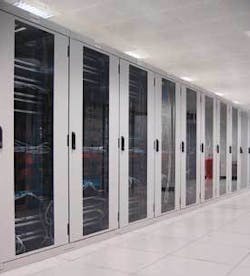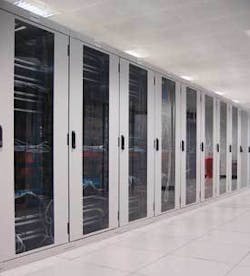Standards guide the way in data center administration
by Patrick McLaughlin
Multiple standards-making bodies have addressed technical and workmanship best practices.
Structured cabling systems within data centers are similar to those in commercial office buildings in several ways, one of the most significant of which is that specifications for their design, installation, and maintenance are spelled out in industry standards. While the TIA/EIA-568 series of standards (currently in a revision process that will result in the “568-C” set of documents) has guided cabling practices in commercial buildings for well over a decade, the TIA-942 Telecommunications Infrastructure Standard for Data Centers is just about two years old.
Published in 2005, TIA-942 was the culmination of efforts within the Telecommunications Industry Association’s (TIA; www.tiaonline.org) TR-42.1.1 data center working group. That’s not to say, however, that only for the past two years has data-center cabling installation been a common practice. It’s fairer to say that the publication of TIA-942 has helped to promote the deployment of structured cabling systems inside data centers.
Defining infrastructure, and much more
Jonathan Jew, president of J&M Consultants (www. j-and-m.com) and co-chair of the TR-42.1.1 working group, says that among the purposes of TIA-942 is to define a standard telecommunications infrastructure for data centers. That statement is part of a presentation on the standard that can be viewed on J&M’s Web site. Among the other purposes of the standard:
- Fill a void by providing nationally recognized standards for the design of data center telecommunications infrastructure;
- Provide information for data center owners to understand data center design tradeoffs and to communicate design requirements to engineers and architects;
- Establish a standard for data center tiers to replace several proprietary standards;
- Encourage early participation of telecom designers and information technology professionals in the data center design process;
- Ensure that data centers can accommodate the needs of their equipment and technologies.
Explaining the benefits of a standardized or structured cabling system versus a proprietary or point-to-point system, Jew says that with a structured system, “Cabling can be used for multiple applications rather than installed for one application and then removed, or just left under the floor.” That saves the owner money, allows flexibility to deploy connections more quickly, and helps to minimize the cabling mess under a data center floor.
Other benefits of a structured approach, Jew says, are:
- Users can choose from multiple sources rather than relying on a single source;
- Structured systems will provide support for future high-speed protocols;
- Structured systems allow simpler troubleshooting and administration, ultimately improving uptime.
Pick a spec
The TIA-942 standard has taken hold in North America over the past two years, and worldwide, other standards organizations are following suit with their own specifications related to data-center infrastructure. For example, the International Organization for Standardization (ISO; www.iso.org) is developing ISO/IEC 24764, an international data center standard. The first committee draft of that specification set was recently completed. ISO is also creating a data center section within ISO/IEC 147632-Information Technology Implementation and Operation of Customer Premises Equipment.
Additionally, the European Committee for Electrotechnical Standardization (CENELEC) recently completed CENELEC EN 50173-5 Information Technology-Generic Cabling Systems Part 5: Data Centers. That approved standard will soon be published and available for purchase.
“These standards follow structured cabling principles similar to TIA-942, but address only cabling,” Jew states. “Unlike TIA-942, they don’t cover data center pathways, spaces, and data center design, and do not restrict horizontal cabling distances for all media to 100 meters.”
Other differences, he continues, “are that the CENELEC and ISO/IEC documents specify Category 6 as the minimum-quality unshielded twisted-pair cable for horizontal cabling, whereas TIA specifies Category 5e at minimum. TIA permits the use of 75-Ω coaxial cable for T-3, E-1, and E-3 circuits; coaxial cable is not specified by the CENELEC or ISO standards.” Jew adds that all three standards support singlemode and multimode fiber-optic cabling, noting that each recommends 850-nm laser-optimized, or OM3, 50-µm fiber when multimode is used.
TIA addenda
Meanwhile, back within the TIA realm, standardization efforts concerning data centers continue. An addendum to TIA-942 is in the works, as is an addendum to the TIA/EIA-606-A standard that will specifically address administration of computer-room cabling systems.
The addendum to TIA-942 will specify the use of coaxial cabling in data centers. The addendum to TIA-606-A is being developed because the standard does not accommodate one of the basic facts-of-life for data center managers-that several cabinets and/or racks exist in the same space. In other words, simply knowing in which room on which floor of which building a rack is located is not sufficient identification in a data center, where it is possible to find hundreds of racks in a single room.
The addendum to 606-A will be based on an informative annex found in TIA-942, and will include information on establishing a grid structure to identify cabinets/racks in computer rooms, equipment rooms, data centers, and similar facilities. While this grid concept might seem straightforward, especially considering the raised floors in data centers form a grid that could be perfect for this use, it is nonetheless essential when one considers that data center managers can move open-frame racks readily, thereby requiring a systematic administration approach.
BICSI weighs in
BICSI (www.bicsi.org), in conjunction with the National Electrical Contractors Association (www.necanet.org), is also addressing data centers in the form of a standard, as work continues on the ANSI/NECA/BICSI-002 standard. J&M’s Jew, the standard’s lead editor, characterizes it as a complementary set of specifications to TIA-942. The standard may be completed as soon as this year, although that appears to be a lofty objective at this point.
A first draft that totaled more than 450 pages was recently completed, and the finished product may ultimately be shorter than that.
“A primary difference between the BICSI data center standard and TIA-942 is that 942 specifies minimum requirements, describes cabling topology, and states the types of cables that should be used,” Jew says. “BICSI accepts TIA-942 as-is, then it takes the annexes to that standard and expands upon them. It is a best-practices document. For example, one annex in TIA-942 discusses electrical systems.”
Jew notes that “the early draft of the BICSI standard has a 50-page electrical section. The BICSI standard is a holistic document that goes into great detail about how to satisfy the requirements found in TIA standards, including 942 as well as 569.”
“What do you mean, no?”
In addition to its current girth, the standard’s status as an ANSI document can play a role in the time it will take to finalize. The process by which it is created must follow ANSI protocol, Jew notes, and it will be reviewed by a wide range of professionals before it can be considered complete. “Any ‘no’ vote that is cast on a draft will be taken very seriously,” he adds.
Despite those challenges, Jew is optimistic the final document will serve its purpose well, and the steps to get to that finished product will be worthwhile. “It has not gotten to the balloting point yet, but there is a good mix of people working on it,” he concludes.
Always a challenging current-event to keep up with, the standards scene surrounding data centers remains an evolving-and growing-circle.PATRICK McLAUGHLIN is chief editor of Cabling Installation & Maintenance.

